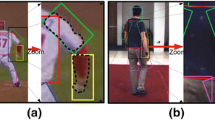Abstract
Of different model-based methods in vision based human tracking, many state of the art works focus on the stochastic optimization method to search in a very high dimensional space and try to find the optimal solution according to a proper likelihood function. Seldom works perform a framework of interactive multiple models (IMM) to track a human for challenging problems, such as uncertainty of motion styles, imprecise detection of feature points and ambiguity of joint location. This paper presents a two-layer filter framework based on IMM to track human motion. First, a method of model based points location is proposed to detect key feature points automatically and the filter in the first layer is performed to estimate the undetected points. Second, multiple models of motion are learned by the prior motion data with ridge regression and the IMM algorithm is used to estimate the quaternion vectors of joints rotation. Finally, experiments using real images sequences, simulation videos and 3D voxel data demonstrate that this human tracking framework is efficient.
Similar content being viewed by others
References
Deutscher J, Blake J, Reid I. Articulated body motion capture by annealed particle filtering [C]// IEEE Computer Society Conference on Computer Vision and Pattern Recognition. Hilton Head, SC, USA: IEEE Computer Society, 2000: 126–133.
Sminchisescu C, Triggs B. Kinematic jump processes for monocular 3D human tracking [C]// IEEE Computer Society Conference on Computer Vision and Pattern Recognition. Madison, WI, USA: IEEE Computer Society, 2003: 69–72.
Agarwal A, Triggs B. Recovering 3D human pose from monocular images [J]. IEEE Transaction on Pattern Analysis and Machine Intelligence, 2006, 28(1): 44–58.
Sidenbladh H, Black M J, Sigal L. Learning the statistics of people in images and video [J]. International Journal of Computer Vision, 2003, 54(1–3): 183–209.
Isard M, Blake A. Consideration-conditional density propagation for visual tracking [J]. International Journal of Computer Vision, 1998, 29(1): 5–28.
Sigal L, Bhatia S, Roth S, et al. Tracking looselimbed people [C]// IEEE Computer Society Conference on Computer Vision and Pattern Recognition. Washington, DC, USA: IEEE Computer Society, 2004: 421–428.
Mori G, Malik J. Estimating human body configurations using shape context matching [C]// 9th European Conference on Computer Vision. Graz, Austria: Springer, 2002: 666–680.
Rahimi A, Recht B, Darrell T. Learning appearance manifolds from video [C]//IEEE Computer Society Conference on Computer Vision and Pattern Recognition. San Diego, CA, USA: IEEE Computer Society, 2005: 868–875.
Bregler C, Malik J. Tracking people with twists and exponential maps [C]//IEEE Computer Society Conference on Computer Vision and Pattern Recognition. Santa Barbara, CA, USA: IEEE Computer Society, 1998: 8–15.
Sminchisescu C, Jepson A. Generative modeling for continuous non-linearly embedded visual inference [C]// Proceedings of the 21st International Conference on Machine Learning. Banff, Alberta, Canada: ACM International Conference Proceeding Series, 2004: 759–766.
Sminchisescu C, Kanaujia A, Metaxas D. Learning joint top-down and bottom-up processes for 3D visual inference [C]//IEEE Computer Society Conference on Computer Vision and Pattern Recognition. New York, USA: IEEE Computer Society, 2006: 1743–1752.
Elgammal A, Lee C. Inferring 3D body pose from silhouettes using activity manifold learning[C] //IEEE Computer Society Conference on Computer Vision and Pattern Recognition. Washington, DC, USA: IEEE Computer Society, 2004: 681–688.
Urtasun R, Fleet D J, Hertzmann A, et al. Priors for people tracking from small training sets [C]//IEEE Computer Society Conference on Computer Vision and Pattern Recognition. San Diego, CA, USA: IEEE Computer Society, 2005: 403–410.
Urtasun R, Fleet D J, Fua P. 3D people tracking with Gaussian process dynamical models [C] //IEEE Computer Society Conference on Computer Vision and Pattern Recognition. New York, USA: IEEE Computer Society, 2006: 238–245.
Tong M L, Liu Y C, Huang T S. Recover human pose from monocular image under weak perspective projection[C]//International Conference on Computer Vision in Human-Computer Interaction. Beijing, China: Springer, 2005: 36–46.
Li R, Yang M, Sclaroff S, et al. Monocular tracking of 3D human motion with a coordinated mixture of factor analyzers [C]//9th European Conference on Computer Vision. Graz, Austria: Springer, 2006: 137–150.
Wachter S, Nagel H H. Tracking persons in monocular image sequences [J]. Computer Vision and Image Understanding, 1999, 74(3): 174–192.
Ivana M, Mohan T, Edward H, et al. Human body model acquisition and tracking using voxel data [J]. International Journal of Computer Vision, 2003, 53(3): 199–223.
Sminchisescu C, Triggs B. A robust multiple hypothesis approach to monocular human motion tracking [R]. Paris, French: The French National Institute for Research in Computer Science and Control, 2001.
Alexandru O B, Black M J. An adaptive appearance model approach for model-based articulated object tracking [C]//IEEE Computer Society Conference on Computer Vision and Pattern Recognition. New York, USA: IEEE Computer Society, 2006: 758–765.
Blom H A P. The interacting multiple model algorithm for systems with Markovian switching coefficients [J]. IEEE Transactions on Automatic Control, 1988, 8(33): 780–783.
Bar-Shalom Y, Chang K C, Blom H A P. Tracking a maneuvering target using input estimation versus the interacting multiple model algorithm [J]. IEEE Transaction on Aerospace and Electronic Systems, 1989, 25(2): 296–300.
Author information
Authors and Affiliations
Corresponding author
Additional information
Foundation item: the Research Fund for the Young Teacher of Shanghai (No. Z-2009-12) and the New Teacher Fund of Shanghai University of Electric Power (No. K-2010-16)
Rights and permissions
About this article
Cite this article
Tong, Ml., Bian, Hq. 3D human motion tracking by using interactive multiple models. J. Shanghai Jiaotong Univ. (Sci.) 16, 420–428 (2011). https://doi.org/10.1007/s12204-011-1134-3
Received:
Published:
Issue Date:
DOI: https://doi.org/10.1007/s12204-011-1134-3




